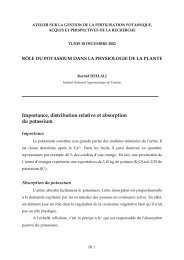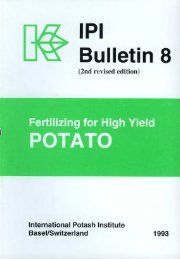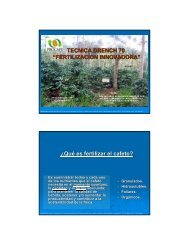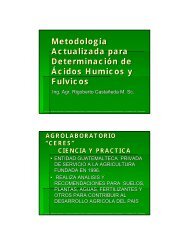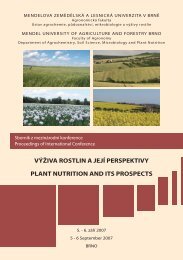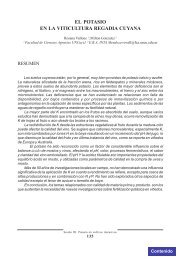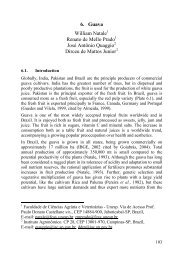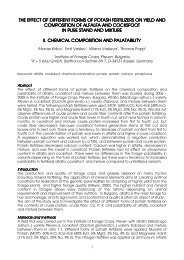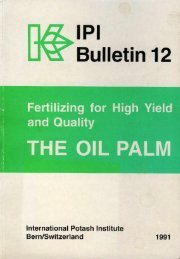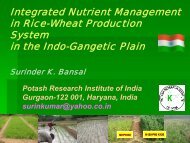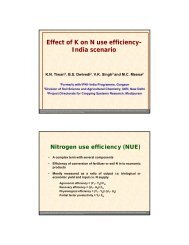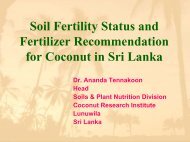Potassium Research and Agricultural Production - The International ...
Potassium Research and Agricultural Production - The International ...
Potassium Research and Agricultural Production - The International ...
You also want an ePaper? Increase the reach of your titles
YUMPU automatically turns print PDFs into web optimized ePapers that Google loves.
ciency in plants: (a) soluble carbohydrates <strong>and</strong> reducing sugars accumulate; (b) starch<br />
<strong>and</strong> glycogen syntheses are impaired; (c) amino acids accumulate <strong>and</strong> protein synthesis<br />
is blocked; (d) the utilisation of respiratory substrates is retarded; (e) oxidative phosphorylation<br />
<strong>and</strong> photophosphorylation rates are decreased, etc. <strong>Potassium</strong> ions have a<br />
fundamental influence on a whole series of different metabolic processes in plants. In<br />
the main lecture H.J.Emns <strong>and</strong> R.A. Wildes had described the fundamental role of<br />
potassium, to be a co-factor for a large number of enzymes that participate in several<br />
major metabolic processes. Of all univalent cations present in normal living tissues.<br />
only potassium has the appropriate properties, <strong>and</strong> is present in cells in sufficient concentration,<br />
to fulfil! the requirements of the great majority of enzymes which depend<br />
for their activity on univalent cations. <strong>The</strong> influence of potassium on photosynthesis<br />
was not discussed in the session; but shortage of potassium does lessen photosynthesis<br />
activity, partly as a result of alterations in protein metabolism <strong>and</strong> the impaired functioning<br />
of a specific enzyme. <strong>Potassium</strong> supply also affects the production of chlorophyll,<br />
on which photosynthesis depends.<br />
1.2. Second Session<br />
This session was closer to agriculture <strong>and</strong> dealt with uptake <strong>and</strong> distribution of K in<br />
plants <strong>and</strong> its interactions with other ions, effects on transport processes <strong>and</strong> on the<br />
water economy in plants. <strong>The</strong> use of plant analyses in assessing nutrient status was discussed.<br />
<strong>The</strong>se are some of the points Professor Mengel made in summarising the session:<br />
Nitrogen nutrition <strong>and</strong> nitrogen metabolism have large effects on uptake <strong>and</strong> distribution<br />
of inorganic ions. A balance between cations <strong>and</strong> anions is essential for normal<br />
plant life. This balance is important both in considering gross uptake <strong>and</strong> release<br />
by plant roots <strong>and</strong> also balance in other plant parts. Uptake of ions from the nutrient<br />
solution involves a balance between inorganic ions, whereas in the plant itself the organic<br />
anions have a large part in balancing the bulk of cations. Ion content <strong>and</strong> ion distribution<br />
do not depend only on N metabolism, but also on the ability to be actively<br />
transported through biological membranes. SCOll Russell had said potassium can be<br />
transported against an electrochemical potential gradient, for calcium <strong>and</strong> sodium<br />
such active uptake by cells of higher plants has not yet been proved. This unique feature<br />
of potassium absorption enables the root to take up large amounts of potassium,<br />
even from dilute solutions. This property is inherent in the whole length of plant roots,<br />
<strong>and</strong> a short segment can supply the entire plant with potassium, provided the environment<br />
supplies enough K to this segment. <strong>The</strong>refore the potassium transported to the<br />
roots, rather than the root surface, controls total potassium uptake; however we do<br />
not know which part of a plant's root system takes up nutrients in the field. This<br />
unique property of potassium, to be accumulated in plant cells by active uptake mechanisms,<br />
affects the water economy too. An accumulation of potassium in the xylem<br />
vessels gives an osmotic gradient, which is responsible for water uptake from the root<br />
environment <strong>and</strong> for root pressure. Also the potassium accumulation in the guard cells<br />
of the stomata, affecting stomatal opening <strong>and</strong> closing, plays a major role in water<br />
economy.<br />
<strong>The</strong> high potassium concentration found in sieve tube vessels justifies the assumption<br />
that potassium is actively secreted into the sieve tubes where it is the dominant cation<br />
balancing the various organic anions. Possibly the favourable influence of potassium<br />
on the transport of photosynthates from the leaves to the storage organs is caused by<br />
31



